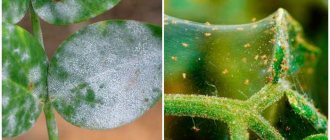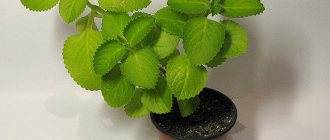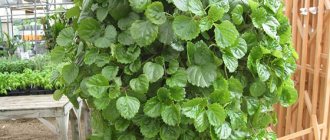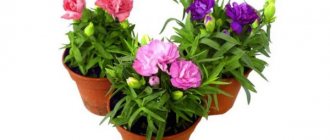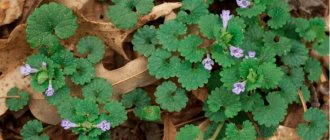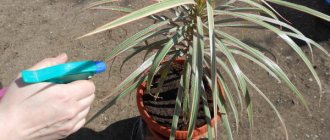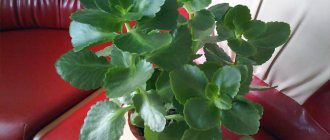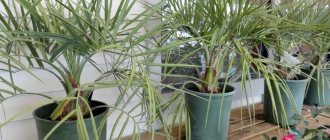Mint is a deciduous subtropical plant. Homeland - Africa, Asia, Australia. The healing properties of mint have been known since ancient times and are now widely used. It is used in cooking, cosmetology, perfumery, and medicine. The most famous varieties are lemon, meadow, fragrant, aquatic, field, pepper or menta piperita. Indoor mint, called plectranthus, is grown indoors. It grows quickly, is unpretentious, and reproduces easily.
Varieties of Plectranthus or indoor mint
Like all Lamiaceae, plecranthus is valuable for its fragrant leaves. And they smell thanks to special glands in the leaves that secrete essential oils. In indoor floriculture, several varieties of plecranthus are known, and the most popular of them are three:
- Plectranthus bush or Moth tree is an evergreen shrub reaching one meter in height;
- Southern plectranthus, also known as Swedish or Scandinavian ivy, is a herbaceous plant with lodging shoots reaching a meter in length;
- Plectranthus Ertendahl (has no other names) is an evergreen subshrub, the crown of which forms clumps.
However, the most common type of home mint in indoor floriculture is the Moth tree. This is what they mean when they talk about growing indoor mint. And it looks more like garden mint than its other brethren.
Conditions of detention
As already mentioned, this plant is unpretentious. However, for favorable growth and reproduction it requires certain conditions. Plecranthus bush (domestic mint) grows well on fertile substrates and organo-mineral fertilizers. He does not like exclusively mineral supplements. This plant is light-loving and needs year-round (evergreen after all) bright, but diffused lighting. The leaves of homemade mint are pubescent, like those of a violet, so it does not tolerate spraying well, and when water gets on the leaves and stems, spots appear on them, which then dry out or rot. But this plant requires abundant watering in the warm season and moderately abundant in winter.
In nature, the moth tree grows in a temperate climate, so when kept indoors, an average temperature of about 20-24°C is favorable for it. However, homemade mint can also tolerate hot weather, but hypothermia is destructive for it. The minimum temperature this plant can withstand is 10 degrees Celsius. Homemade mint is undemanding in terms of air humidity, but does not tolerate proximity to a heating radiator or dry hot air. So the ideal conditions for this plant would be a warm, bright room, good watering without spraying, and fertilizing with flower fertilizers twice a month.
Possible growing difficulties
If you do not provide the flower with optimal conditions and regular care, it will get sick and suffer from pest attacks.
Important! If harmful insects or signs of disease are detected on a flower, it is necessary to immediately isolate it from other plants and treat it.
Pests
Indoor mint can be affected by the following parasitic insects:
- Spider mite. The main sign of damage is the entwining of the stem and leaves with cobwebs. Dry air is a favorable condition for tick invasion. The fight against the parasite is carried out by wiping the leaves and trunk with a soap solution, dishwashing detergent, abundant watering and covering the bush with film for 3 days, treating with acaricides “Apollo”, “Borneo”, “Floramite”, “Flumite”.
- Aphid. Symptoms of damage are drying of the leaves, wilting of the buds, and the appearance of honeydew on the leaves and stems. The destruction of the insect is carried out by wiping with a soap solution, medical alcohol, spraying with garlic, tobacco infusion, as well as infusions of wood ash, hot pepper, and tomato tops. Among the chemicals used are “Fitoverm”, “Iskra”, “Inta-vir”, “Aktellik”, “Karate”, “Confidor”.
- Shchitovka. This insect can be seen on the stem. It sucks nutrients from the plant, causing the flower to wither and disappear. The first symptoms of scale insects are a sticky liquid on the trunk. For control, a mechanical method is used - insects are scraped off with a brush. Folk remedies - rubbing with vinegar solution, garlic, pepper tinctures. In case of severe infection, they resort to chemical treatment using Fitoverm, Actellik, Metaphos.
- Whitefly. It is difficult not to notice the whitefly. Moths with white wings are often found above the plant. However, it is not the butterflies that pose the danger, but their larvae that feed on the leaves. As a result, they turn yellow and curl. To combat whiteflies, the above-mentioned insecticides are used. Soap solution, tobacco and dandelion infusions also help to repel insects.
Diseases
The following diseases are diagnosed in plectranthus:
- Downy mildew. It appears as gray spots on the upper leaf plate and a gray coating on the lower one. The main reason is too much watering and high humidity. To get rid of the disease, it is necessary to eliminate the causes - dry the earthen lump and air. For treatment, spray the leaves and stems with a mixture of serum (1 part) and water (3 parts); a mixture of soap (40 g), soda (50 g) and water (10 l). In case of severe damage, it is necessary to use fungicides approved for indoor plants: “Topaz”, “Skor”, “Dektra”.
- Root rot. Manifested by yellowing and falling leaves. Develops in case of excessive moisture. The plant will need to be treated with fungicides and replanted.
Important! When treating a flower with chemicals, you must adhere to personal safety rules. Carry out the treatment in a well-ventilated area, protect the eyes, nose, mouth, hands and body with special equipment. It is prohibited to drink, drink or smoke.
In addition to diseases, the plant can also suffer due to errors in care. If it lacks something, it will signal this by changes in appearance. The most common problems encountered when growing mint are:
- Exposing the stem, shredding the foliage. Occurs due to insufficient lighting. It is necessary to move the flower to a brighter place or organize artificial lighting.
- Lightening of leaves. This is a sign of excessive lighting. It is necessary to protect the flower from sunlight.
- Falling leaves, wilting shoots. May indicate a lack of moisture. It is necessary to increase the quantity and volume of moisture.
- Root rotting, yellowing and falling leaves. May indicate over-hydration. The irrigation regime should be changed and its volume reduced.
- Lack of flowering and falling leaves. Can occur when the flower is grown in temperatures that are too cold.
So, indoor mint is a beautiful and unpretentious plant, which can be grown by a beginner in the flower business. It is placed on the windowsill, and it is used to landscape balconies, loggias, and terraces. Grown in flowerpots, pots and containers, in winter gardens.
Plectranthus propagation
All varieties are most easily propagated by cuttings. After pinching off a piece of at least 10 cm, it is placed in water for several days. To activate the process and obtain a more developed, strong root system, a root formation stimulator (Heteroauxin, Kornevin) is added to the water. You can plant cuttings when the roots have grown 5-10 mm. The survival rate of Plectranthus is very high.
When transplanting into new containers, adult indoor mint bushes are divided if too many shoots have grown from the root. The plant is completely freed from the soil and the root system is washed. Cut into pieces with a sharp knife. It is necessary to divide it so that each new bush has strong, healthy roots and several shoots.
Growing mint from seeds
Propagation by seed is the most difficult method. But this method is necessary if you need mint of a specific variety. It is advisable to use purchased seeds. When breeding from independently collected seeds, varietal genes are not always inherited. Below is a step-by-step description of the seed method of planting mint on a windowsill:
- The procedure is carried out in March or April.
- The seeds are immersed 5 mm in moistened soil and covered with a thin layer of peat.
- The pot is covered with glass or polyethylene.
- Do not allow the soil to become waterlogged or dry out. The surface soil layer is sprayed if necessary. Periodically move the glass so that the soil does not rot.
- Seedlings appear on days 15-18. When development reaches the stage of two true leaves, young greenery is planted in separate containers.
Types of homemade mint
There are more than 250 species of plants in the genus Plectranthus, which, at times, are not at all similar to each other.
Plectranthus coleus. A shrub with erect shoots up to 1 m high and covered with ovoid shiny leaves. The plant has tetrahedral shoots. The stems and soft petioles are pubescent. The crenate leaves are bright green with white spots or stripes along the edges.
Plectranthus coleus
Plectranthus Ertendahl. A herbaceous perennial with creeping shoots up to 40 cm long, it is used as an hanging plant. The petiolate opposite foliage, about 6 cm long, is ovoid or round in shape and dark green in color. On the surface of the leaf there is a silvery ornate pattern along the veins. The bottom of the leaves are covered with short reddish fibers. In summer, racemose inflorescences up to 30 cm long bloom at the tops of the shoots. Each individual bell of light purple or white color grows up to 1.5 cm in length.
Plectranthus Ertendahl
The hybrid variety Plectranthus Mona Lavender is very popular. An erect shrub with brown-brown stems is covered with large ovate leaves of dark green color. The surface of the serrated leaves is glossy, and the reverse side is covered with purple hair. In early September, long, dense inflorescences with large tubular flowers of a violet-blue hue with blue specks grow.
Plectranthus Mona Lavender
Plectranthus oakleaf. The plants have fleshy, erect stems covered with serrated, leathery leaves that are shaped like oak foliage. The leaves are dark green and covered with short silvery hair. If you rub them between your fingers, a rich pine aroma will remain.
Plectranthus oakleaf
Mint varieties for growing on a windowsill
In apartment conditions, the same varieties and varieties are suitable for growing as for open ground.
Popular varieties include:
- Pepper;
- Feline;
- Curly;
- Home;
- Menthol;
- Lemon;
- Chocolate.
When talking about which variety of mint is best to grow on a windowsill, you need to take into account the dimensions of the chosen location, the height and spreading nature of the adult plant. It is better to choose varieties that are characterized by small roots and a compact above-ground part:
| Variety | Description |
| "Ceremony" | A small bush with deep green leaves. Rich in menthol, has a deep aroma. Excellent for culinary purposes. |
| "Fun" | Shade-tolerant variety. The bush does not exceed 50 cm in height. The taste of the leaves is fresh, menthol. |
| "Pennyroyal" | Compact bush with small purple-green leaves. The aroma is intense. Used for making cocktails and other drinks. |
| "Spearmint" | Low (35-60 cm). It has oval dark green leaves. The aroma is strong and cooling. Ideal for meat dishes and salads. |
If room conditions allow, you can grow larger varieties: Menthol, Moskvichka, Pepper Garden.
Useful properties of the plant
Plectranthus amboinicus gives off a pleasant scent when its leaves are touched. It has widely proven itself in folk medicine. Tea is brewed from the leaves, which can:
- relieve the patient from fever;
- normalize intestinal function.
The plant is considered an anti-inflammatory and analgesic, it has diaphoretic and choleretic effects, and also has a laxative effect. In addition, it is used to make expectorants. Chewing the leaves of the plant will improve your health by relieving nasal congestion and cough. The flower is also believed to help fight asthma attacks.
Tea made from indoor mint leaves will be useful for impressionable people suffering from nervous tension. It can help with insomnia, as it has a calming effect.
Plectranthus aromaticum is also used to combat skin diseases. It relieves itching caused by insect bites. To do this, you need to crush the leaf and apply it to the disturbing place. Helps cope with skin rashes and allergic reactions.
To combat enuresis, medicinal baths with the leaves of the flower are prepared. The recipe for the rescue solution is quite simple. To create it, pour half a tablespoon of crushed raw materials into a liter of boiling water. The solution is infused for two hours, then after filtering it is poured into a warm bath. You need to lie in this water for about 15 minutes.
Plectranthus aromatica
Note! The use of the plant must be agreed with a doctor, as there are contraindications. For example, it is not recommended for use by pregnant women or during lactation.
In addition, use with caution in children, especially before the age of three. People with sensitive skin may experience allergies upon contact with the plant.
Plectranthus in Russia is often called a fly-driver, as it is capable of clearing a room of annoying insects. Essential oils of the molar tree can scare away unpleasant apartment dwellers after a single touch. This is the name given to plectranthus shrubby; it is a plant with heart-shaped leaves and a uniform green color. It has virtually no rest period. The moth tree grows actively in summer and blooms from mid-winter to spring. This is one of the longest flowering periods of any Plectranthus species.
Plectranthus, the care of which at home is designed to replicate the climate of the subtropics, looks spectacular in hanging pots. Some species are distinguished not only by attractive leaves, but also by abundant flowering. In addition, the plant has medicinal properties and is famous for its widespread use in folk medicine. Plectranthus is used not only to treat diseases; in the cuisines of some countries it is added to soups and drinks. In Indonesia it is used as a preservative for meat and fish.
How to use homemade mint in folk medicine
The use of fragrant spur flower is practiced in home medicine. The anti-inflammatory, analgesic and strengthening properties of the plant have a positive effect on the body for many ailments.
For enuresis
The benefits and harms of decorative indoor mint allow the plant to be used for enuresis in children and adults. An infusion is prepared based on the spur flower, which is then added to healing baths. The algorithm looks like this:
- Dry or fresh plectranthus leaves are crushed in the volume of a glass.
- Pour the raw material with 500 ml of hot water.
- Leave covered for 45 minutes.
- Strain and pour the product into a filled bathing container.
It is necessary to take such a bath for half an hour shortly before bedtime. The water temperature should only be about 30 °C. Baths are taken daily or every other day until the condition improves. The procedures not only help get rid of enuresis, but also increase skin tone.
The infusion of indoor mint does not last long, so it should be prepared anew every day.
When coughing
The healing properties of aromatic plectranthus improve expectoration during colds and help relieve coughs. Traditional medicine recommends preparing the following remedy:
- About 10 g of dried leaves of the plant are poured into the teapot.
- Pour 300 ml of hot liquid into the raw material.
- Cover with a lid and leave for 15 minutes to infuse.
- Strain through a strainer and pour into cups.
You can drink medicinal tea 2-3 times a day on a full stomach.
Advice! If desired, plectranthus leaves can be mixed in equal volumes with regular tea leaves.
For psoriasis
Indoor mint copes well with skin irritations and has a beneficial effect on psoriasis, eczema and other diseases. It is recommended to use a simple infusion of an ornamental plant. They do it like this:
- Grind clean fresh leaves in the volume of half a glass.
- Brew the raw material in 1 liter of boiling water.
- Leave the infusion in a closed container for a couple of hours.
- After time, filter.
In the finished product, you need to moisten a clean cloth or gauze and treat the affected areas of the skin. It is allowed to wipe the epidermis 4-5 times a day. The infusion has a good effect on diaper rash in children and bedsores in the elderly.
For insect bites
Itching, burning and pain from insect bites are well relieved by fresh plectranthus juice. The plant is used as follows:
- Several leaf blades of the spur flower are thoroughly ground to a paste.
- Squeeze the raw material through cheesecloth to obtain pure juice.
- Soak a cotton pad in the liquid.
We recommend reading: Medicinal properties of tzmina (immortelle) herb and contraindications
The juice is applied to the bite sites several times a day. The product can also be used to wipe inflamed wounds and cuts.
Conditions for plectranthus
The decorative leaf plant plectranthus is considered unpretentious at home, but for this you need to provide the plant with the necessary minimum. Having chosen the right place and set up a watering regime, the gardener can enjoy the rich greenery and delicate aroma of spur flowers for many years.
Location and lighting
Indoor plectranthus is placed in well-lit places where direct sunlight does not reach. The abundance of diffused light stimulates the active growth of green mass. Monochromatic species of spur flowers do well in partial shade. Leaves with ornaments and variegated varieties require more light, otherwise the color will fade.
In winter, the duration of daylight hours is extended with lamps (fluorescent or cold-spectrum LED). Lack of lighting leads to thinning of the shoots. The leaves become small, pale, grow less frequently - the decorativeness of the plectranthus decreases. The need for lighting appears when it is not possible to provide a cool winter for the flower. If during the cold season a pot of plectranthus is placed in a room with a temperature of 12-16°C, the plant does not need additional lighting.
The best place is western or eastern window sills, where direct rays occur only in the morning or evening, but they do not burn the leaves as much as on southern windows. The room is regularly ventilated, but spur flowers do not like drafts. In summer, the flower is taken out onto the balcony or into the garden.
Temperature
The tropical plant loves warmth in summer and moderate temperatures in winter. During the active growing season, he is more comfortable when the thermometer shows 20-25°C. The dormant period of spur flowers takes place at 12-16°C. Going beyond these limits - both above and below - threatens the health of the plectranthus.
Air humidity
It is not recommended to spray hairy leaves, but dust accumulates between the fibers. It prevents the plant from breathing and reduces its ability to photosynthesize. And the sight of a plant faded under a layer of dust is not encouraging. Therefore, Plectranthus is periodically given a warm shower. The leaf plates are cleaned and saturated with moisture. Water procedures are especially relevant when the temperature rises above 25°C and it is difficult for the plant to cope with the heat.
Additional measures to increase humidity during hot periods are a tray with pebbles filled with water. Evaporating moisture saturates the air, reducing plant discomfort from overheating.
The soil
The houseplant plectranthus is planted in universal flower soil with neutral acidity. A self-assembled planting mixture consists of equal amounts of humus, sand, leaf and turf soil.
How to care after planting
Mint is a heat-loving plant; to maintain normal growth and development, it is moved, if necessary, from one place to another in order to maintain a temperature of 20-26 °C. Moving mint around in its pot at home helps protect the tender leaves from sunburn from the midday sun.
In summer, a pot of mint is stored on the balcony or covered veranda. In hot weather, a container with water is placed near the plant, the evaporation of which allows you to maintain the required level of air humidity.
During the winter months, it is better to remove mint from the windowsills, as low temperatures will penetrate through the window, which will have a detrimental effect on the plant. The optimal temperature regime in the cold season is 17-20 °C.
Description of Plectranthus
Indoor spur flower (Plectranthus from Greek plectron - spur, anthos - flower) is a fast-growing crop. A large selection of ampelous and erect forms allows connoisseurs of plectranthus to assemble entire collections, because each variety is interesting in its shades of green and the shape of its leaf blades.
No matter how different the shape and color of the leaves of the family may be, the plants have inflorescences of the same type, which gave them their name - Lamiaceae. One lip of the corolla is bent upward, it is short, the second, below, is much longer. There are 4 stamens between them, two of which are shorter. The flowers, when viewed individually, are small and inconspicuous. They decorate greenery with tall spikelets in spring or summer. They are not given a decorative role in indoor culture; they are often torn off. But if you achieve abundant flowering of plectranthus, then many soft blue, dark blue, lilac or almost white inflorescences simultaneously bloom above the dense green leaves.
The shoots are usually tetrahedral and branch profusely. The leaves of different varieties differ in size and shades of color. They are pubescent and smooth, shiny and matte. Oppositely located, growing close to each other, they form a dense carpet or a thick lush pillow, for which they are valued by gardeners.
The most popular are the hanging varieties. The cascading spur flower is called nothing less than Scandinavian or Swedish ivy. In countries with harsh climates, plants that can completely cover vertical and horizontal surfaces have received special recognition in indoor floriculture.
Planting and care
Plectranthus are planted in medium-sized pots using the transfer method so as not to damage the rhizome. If the plant's condition is not very good, it is necessary to clean off some of the soil and check the roots for rot. All damaged areas are cut off. The pot should have holes for draining water, and drainage material should be poured onto the bottom to 1/4 of the height of the container. The soil for planting should be light and breathable with a neutral or slightly acidic reaction. It can be composed of the following components:
- turf (2 parts);
- leaf humus (1 part);
- leaf soil (1 part);
- coarse sand (1/2 part);
- peat (1/2 part).
Subsequently, transplantation is carried out every other year in early spring.
Lighting. Plectranthus does not like direct sunlight on its leaves. It grows well in partial shade. In autumn and winter, it rarely needs additional lighting. Even during the flowering period, it only needs a few hours of sunlight.
Temperature. Homemade mint prefers moderately warm conditions. During the active growing season, the air temperature in the room should be +18…+25°C. It is recommended to take the plants outside in the summer, but reliable protection from drafts is necessary. In winter, a cool rest period should be ensured at a temperature of +12...+16°C. Without such a cold snap, additional lighting will be needed.
Humidity. Plectranthus thrives at normal air humidity. In winter, especially near radiators, periodic spraying of leaves is recommended. Several times a year, the flower is bathed in a warm shower to remove dust.
Watering. The flower needs to be watered abundantly and often. However, between waterings the soil surface should dry out by 1-2 cm. Stagnation of liquid is unacceptable. Water for irrigation must be thoroughly purified and settled.
Fertilizers. In spring and summer, plectranthus are fed twice a month. Use mineral and organic fertilizers for decorative foliage plants. The fertilizer solution is applied to the soil. In winter, one mineral fertilizing per month is enough.
Trimming. Plectranthus shoots grow very quickly. In this case, their lower part may become exposed and lose its decorative effect. To keep the flower beautiful longer, it must be trimmed regularly. Pruning is combined with replanting. The shoots are shortened by at least half, and the tips of the shoots are also regularly pinched for greater branching.
Diseases and pests. Plectranthus is resistant to plant diseases, but suffers from root rot if overwatered. Only occasionally do spider mites settle on its leaves, which can be quickly eliminated with the help of insecticides.
Collection rules
Mint is a quick-ripening plant: the first leaves can be tasted within three weeks after germination. However, “commercial” harvesting of greens is possible no earlier than two months later. The leaves become most fragrant during the formation of peduncles: the content of essential oils reaches a maximum at this moment. Harvesting is possible throughout the year, but in winter the leaves are cut off in very small quantities. Trimming mint only stimulates the appearance and growth of new leaves.
If growing a spice involves obtaining mint oil, you have to cut almost all the greens for this: there may be two or three such cuttings over the summer.
Systematic collection of small amounts of greenery has virtually no effect on the condition of the bush, but it is better to do it according to the rules:
- The entire shoot can be cut off when it grows to 15-17 cm, but it is better to leave 2/3 of the length of the shoot on the plant;
- when tearing off individual leaves, you should do this 1-2 cm from the stem: this technique promotes tillering;
- There is no need to let mint bloom: if you wait until the flowers open, the aroma will sharply decrease.
- When harvesting, most gardeners prefer to cut off the tops of the bushes 1-2 cm above the point where the side stem departs from the main one.
Mint stores well in the refrigerator in a loosely sealed bag or container. The excess can be dried: do this in the shade at room temperature, the drying time is until the stems become brittle.
Growing mint on a windowsill is just as popular and not difficult as growing dill, parsley, and other spicy herbs. And if most edible herbs are annuals, mint in a pot will decorate your apartment in winter.
Home care
When purchasing plectranthus, home care should be based on the fact that the plant comes from a subtropical climate. It is characterized by long daylight hours, warmth and high humidity.
Watering
The plant requires abundant watering, especially during the growth period. Spraying is also welcome as a way to create conditions of high humidity. This is especially true in the hot season, when the room temperature is above 22 degrees.
Note! It is important that the soil in the pot does not dry out completely. Although if this condition is maintained for a short time, nothing will happen to the plant. Water for irrigation is used at room temperature, it is pre-settled
Water for irrigation is used at room temperature and pre-settled.
Sometimes the plant is given a warm shower, first covering the pot with film so that the liquid does not get into the soil. The procedure will help get rid of dust accumulating on the leaves.
If there is insufficient air humidity, you can use pebbles or expanded clay. To do this, drainage material is immersed in water and poured into a container on which a flower pot is placed.
In winter, the flower hardly grows, so the frequency of watering is reduced. Once every 4 days is enough. At this time, on the contrary, excessive waterlogging is dangerous, which can lead to stagnation of water and rotting of the root system.
The soil
The soil for growing plectranthus should not be too dense. You can purchase a ready-made mixture or make it yourself. For this you will need:
- humus - 2 parts;
- turf – 2 parts;
- leaf soil - 1 part;
- sand (river) – ½ part;
- peat – ½ part.
Top dressing
You need to feed the plant with fertilizers from the beginning of spring to the end of summer. They must be paid once every month. To do this, use fertilizers intended for flowering flora. You can alternate organic and mineral products.
Temperature
Plectranthus mint lives comfortably at average temperatures, that is, at 20-22 degrees. It does not bloom in winter, there is no active growth, so it needs cooler conditions.
Important! The main thing is that the temperature does not drop below 15 degrees. Otherwise, the plant will begin to wither, the leaves will fall off, which may ultimately lead to death.
If you cannot arrange a flower in a room with a cool temperature during the cold season, you need to provide it with additional lighting.
Lighting
Indoor mint loves bright, but diffused sunlight and does not tolerate direct rays. It is ideal to place the flower pot on a windowsill facing southwest.
Plectranthus in sufficient light
If there is a lack of sun, additional lighting must be provided artificially, otherwise the color of the leaves will become dull, which will affect the attractiveness of the plant.
Diseases and pests
Mint rarely gets sick, but sometimes problems arise.
| Problem/Manifestations | Causes | Elimination |
| The leaves wither and burn out. | Exposure to direct sunlight. | Shade or move to another place. |
| Yellowing, shedding of leaves. | Low temperature +12…+16 °C excessive moisture. | Increase the room temperature or reduce watering. |
| The roots are rotting. | Stagnation of water, acidification of the soil, cold air. | |
| Drooping leaves in summer. | Dry air. | Spray more often, install humidifiers. |
| The leaves fall off and the plant does not bloom. | Too hot, lack of light. | Increase lighting, lower temperature. |
| Gray-violet spots. | Downy mildew (downy mildew). | Remove the affected parts. Treated with fungicides (Aktofit). |
| White plaque. | Powdery mildew. | Spray with serum with 1/3 water or colloidal sulfur. |
| Curling leaves, green insects on them. | Aphid. | Treat with tobacco infusion, in advanced cases with Fitoverma, Iskra. |
| White or silvery web. | Mite. | Used for treatment with Actellik. |
Reproduction methods
It is not difficult to propagate homemade mint plectranthus; the main thing is to follow the sequence of steps and do everything carefully so as not to damage the plant.
Cuttings
In winter or spring, the plant is pruned. This is necessary to create the shape of the plant, get rid of weak stems, and remove old leaves. At this time, you can prepare the shoots for transplantation.
Sequence of actions when propagating by cuttings:
- Shoots with at least three buds are harvested;
- Drainage and prepared soil are poured into the pots. It is necessary to disinfect and moisten it in advance;
- The cuttings are placed in the soil, making small holes with a pencil. You can plant several shoots in one pot, then the bush will turn out more lush;
- Water young plants as the top layer of soil dries.
Rooting in water
After 1-2 weeks, the plant usually develops roots. This is evidenced by new leaves growing on the stem. You can also root cuttings in water or sand.
Dividing the bush
Reproduction by dividing the bush is carried out during plant transplantation. After the flower is removed from the pot, carefully shake off the roots and cut with a sharp knife
It is important to disinfect it in advance to prevent infection of the plant.
The cut sites are processed:
- ash;
- activated carbon powder.
New plants are placed in a pot and the free spaces are filled with soil. Before planting, moisten the soil.
Growing mint by cuttings
For planting, cuttings are taken, separated from the tops of adult shoots. Below we tell you how to grow mint on a windowsill using cuttings:
- Cut branches up to 8 cm long are treated with a biostimulant solution.
- The lower leaves are cut off, after which the cuttings are placed in water.
- After a week or two, roots form. Plants are moved into the ground.
- 2 weeks after planting, young mint is fertilized with a urea solution (1 g per liter of water).
Benefits and superstitions
In addition to its attractive crown, plectranthus helps improve health. It serves as an effective diuretic, anti-inflammatory and expectorant, and also helps calm the nerves. The tops of young shoots with buds are used for medicinal purposes. Medicinal tea is brewed from them.
The aromatic leaves of plectranthus are used as a seasoning for meat, poultry and sauces. Leaves of different types smell of mint, thyme and oregano, which allows you to create a whole composition.
The rich aroma repels some insects; it is not for nothing that plectranthus is also called the “moth tree”. Bags of dry leaves are placed near clothing to prevent moths from appearing. If you rub the skin with fresh plant juice, mosquitoes will bother you much less.
People who believe in omens and superstitions recommend plectranthus for indoor growing. Since the leaves of some species resemble small coins, the plant is called a “money tree.” It is believed that it attracts wealth to the home, and also protects household members from insomnia, anxiety and bad thoughts.
How to grow mint at home from cuttings
10-centimeter sprigs of mint, cut at an angle of 45 degrees, from which the lower leaves must be removed, are suitable as cuttings.
Propagation of mint by cuttings
The cuttings are dipped in a glass of water for 3-8 days until roots appear, after which they are planted in prepared soil. To create greenhouse conditions, the cuttings are placed under a glass or plastic cap.
It is recommended to update the sections of purchased seed before rooting and only then place it in water. To speed up root germination, you can add a drug that stimulates root formation to the water.
Interesting! Some gardeners do not consider it necessary to root the cuttings in water, immediately placing the shoot in the ground.
Main types
Plectranthus can be annual or perennial. This is a hanging plant, characterized by drooping branches. Therefore, it must be planted in hanging pots. Non-ampelic plants are also found, but their distribution is not so wide. Types of plectranthus differ not only in leaves, but also in inflorescences. In some plants they are completely unattractive, while others are in demand only due to their unusual flowering.
Plectranthus
The leaves of indoor mint differ in texture and shape, have different edges and colors. For example:
- Southern plectranthus grows horizontally, its leaves are green and covered with wax. Therefore they are dense and smooth;
- Forstera also grows horizontally. The plant is used to decorate loggias and balconies. Its leaves are ovoid in shape and have a pronounced relief. White stripes along the edges contrast with the green color.
- The leaves of Plectranthus oakleaf are covered with hair, so they are fluffy. If you touch them, a pine aroma appears. Their shape is identical to oak leaves, which is reflected in the name;
- Plectranthus variegata is distinguished by heart-shaped leaves. They are colored green and have a white border around the edges.
Plectranthus Ertendahl
Plectranthus Ertendahl, or spur flower, is a perennial shrub whose height does not exceed 20 centimeters. Its leaves are ovoid, even almost round, green. They have a bright pattern along the veins of a silvery hue. On the reverse side, the leaves are red in color and feel rough to the touch.
Plectranthus Ertendahl
Inflorescences form at the top of the plectranthus. They reach a length of up to 30 centimeters. Consist of several large white flowers. The plant reacts to light by changing the shade of its leaves. With too much sun, redness on the back side moves to the front side. This species requires constant pinching to create bushiness.
Plectranthus tomentosa
Plectranthus tomentosa, or hadiensis, is distinguished by the fact that its light green leaves are covered with short down. The color is usually monochromatic, but variegated plants are also found. At the same time, there are different shades, they can be yellow, mint and dark green.
Hadiensis is common in India, where it is used as one of the ingredients in cooking. At home, the plant looks compact, with branches strewn with small leaves hanging from the pot. Under natural conditions, plectranthus can reach 70 centimeters in height. This is one of the most light-loving representatives of indoor mint. During flowering, beautiful blue flowers appear.
Plectranthus Mona Lavender
The stems of Plectranthus Mona Lavender are long, hard, and covered with down. Their color is brownish-brown. The leaves of the plant are glossy, dense, and the surface is jagged. On the other side, purple lint is visible.
Plectranthus Mona Lavender
Peduncles form at the top of the stem; leaves do not grow on them. They are also lightly covered in down. The flowers themselves resemble elongated bells and can have different colors. In nature there are white, lilac, purple, and lavender shades. Due to its attractiveness during flowering, this species has gained the greatest popularity among plant lovers. In addition, the duration of this colorful period is attractive. With proper care, the plant can delight with its bright appearance from February to November.
Collection and preparation
For medicinal purposes, indoor mint leaves are used, and they are taken from the top of the plant. It is recommended to harvest raw materials before and during flowering. During this period, plectranthus leaves contain the maximum amount of valuable substances.
The preparation of medicinal raw materials is carried out as follows:
- The apical part of indoor mint is cut off along with the young leaves with sharp scissors.
- If necessary, wash the raw materials in cold water to remove dust and contaminants.
- Lay the workpiece on a sheet of thick paper in a warm but shaded place.
- Leave until the moisture has completely evaporated.
Indoor mint should not be dried in the sun - the beneficial essential oils present in the leaves are destroyed. For the same reason, raw materials are not processed in electric dehydrators and ovens. Leaves should only be dried naturally. After the moisture evaporates, the raw materials should darken, but retain the characteristic mint aroma.
Transplanting a plant
Transplantation is carried out once a year, in the spring, until the plant reaches five years of age. Then the procedure is performed if necessary, it depends on the growth rate of the flower.
After purchasing, mint plectranthus can be replanted immediately. To do this, you need to purchase a pot that is several centimeters larger in diameter than the previous one. The day before the procedure, the plant is watered abundantly so as not to damage the roots when removed from the container. The earthen ball is not destroyed; it is immediately transplanted into a new pot, filling the empty spaces with prepared soil. It is recommended to place drainage at the bottom to prevent the possibility of root rotting.
Note! Pots should be used high, since plectranthus is characterized by a powerful root system that requires a lot of space
Seed selection
It is recommended to purchase seed material for planting plants from specialized horticultural departments.
Small seeds collected by hand have poor germination.
Before sowing, germination is required. The material is soaked in a container for 1-2 days in gauze or a napkin; cover the dish with a lid.
Description of the plant
Plectranthus is an evergreen shrub or herbaceous plant 60-80 cm high. Branched shoots can grow vertically or spread along the ground. The fibrous root system is located shallow. The ribbed stem is bare or pubescent, and is covered with a bright green or brownish-red skin.
Opposite leaves on short petioles grow in pairs crosswise. They are quite fleshy and have an ovoid or oval shape. The leaf blade can be bare or densely pubescent. The edges of the leaves are covered with small teeth. The relief of veins or a variegated pattern is clearly visible on the surface. Thanks to the aromatic glands, plectranthus leaves emit a pleasant minty or spicy aroma.
Flowering occurs in summer. Short but dense paniculate inflorescences are located at the ends of the shoots. Bisexual flowers consist of five petals that grow together at the base into a tube. The two-lipped corolla is white, lilac, blue or purple. In the center are miniature stamens and the ovary. After pollination, fleshy fruits ripen. There are 4 nuts inside them. The ripe fruit opens on its own.
How to plant mint at home
How to plant mint and grow from seeds in the country
To plant mint in a pot, 2 methods are used: sowing with seeds and cuttings. The second method will allow you to get an adult plant in a shorter time compared to sowing seeds, but if you start planting seeds in advance, you can get the first harvest within the required time frame.
Mint seeds for planting
If mint is already growing on the garden plot, then in the fall you can dig up the bush and transplant it into a container of suitable size. Before planting in a pot, it is recommended to thoroughly clean and rinse the roots from the soil. An adult plant can reproduce in the same way; you just need to divide the root system into several parts.
